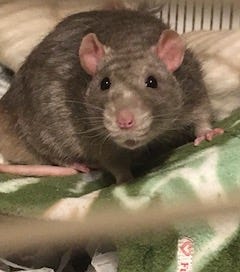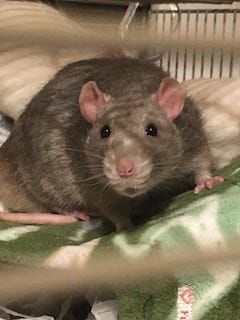I breed for health, but what does this mean?
Most breeders in the National Fancy Rat Society will claim to breed for health and temperament, while they “improve” a particular variety among our nation’s rats. I don’t think any of us ignore health and temperament – we don’t want chronically ill or vicious rats ourselves, and our pet homes don’t either. But there is variation among breeders over how much emphasis we put on one or all of these three pillars of breeding: the appearance, health, and temperaments of our rats.
Then there is the question of how we interpret what is a “good temperament” or even what can be considered “good heath”. For example, if a breeder claims to breed for health but consistently breeds from bucks that are under a year old, they may not be able to estimate the performance of their line of rats as they enter their second year.
I’m not saying I wouldn’t breed a 12-month old rat, but I can’t pretend the reason is due to his excellent health as most rats should be pretty healthy at that age.
Sometimes, you will take a chance. A competent, experienced breeder may use a young buck for a number of reasons. Just as an example, a breeder may have only a handful of rats of a particular variety to choose from and they are trying to prevent the variety from disappearing altogether.
In other cases, a breeder may know their line so well and have been breeding it for so long that the occasion young stud buck is unlikely to produce any surprises.
By contrast, some compromises are made out of ignorance among well-meaning, but inexperienced breeders. The buck’s background may not be known. Meanwhile, he hasn’t bitten anybody so why not use him?
All breeders make compromises on occasion, and we may find ourselves willing to breed a rat that demonstrates a lower standard of a particular trait. For example, the trait that often takes a beating in my rattery is my attendance to the appearance of the rats. I breed Russian dove. However, there is no single gene for Russian dove. The correct colour is arrived at by combining a number of recessive genes. As much as I’d love more doves in my litters, it’s not unusual for me to compromise on the correct shade if there is any question of health or temperament among the rats likely to produce doves. I’ve already written about how I choose for temperament .
I really don’t know what others are considering good temperaments because I don’t know their rats. Some breeders look at me with confusion when I mention temperament, acting as though it’s not a particularly interesting topic. Others are very happy to chat about it.
As for health, when I first started breeding in 2018, I read two articles by Ann Storey, President of the NFRS, in which she emphasised the importance of never using a rat with a health problem, or any other significant problem. “Never breed with an unfit, sick or moulty animal. In rats this includes respiratory disease, skin problems, barbering, tumours and poor temperament.”1 In my short life as a rat breeder (I started in 2019), I’ve found everything Ann states about health to be true and I never breed a rat that makes any kind of respiratory noise or lacks health in any way.
That much is simple to follow, but things get far more complicated when it comes to breeding a line of “healthy rats” because even if you follow all the guidelines, it can still go awry. For one thing, not every ailment is heritable. To make matters more complicated, the husbandry can have a significant impact on their health. So figuring out what is likely to happen in the future when the problems you’ve had so far may not even be linked to genetics can be tricky.
And there will be health problems. Rats are not long-lived creatures. They can easily be overtaken by pathogens that are naturally resident in their respiratory systems. They can quickly get out of condition if stressed. They can certainly injure one another but even when no injuries are evident, high stress over time will cause physical weaknesses or even kill them as surely as a nasty fall.
Those who have been breeding for decades and (importantly!) who have made an effort to understand the consequences of breeding decisions over time in their lines, have a far greater depth of understanding about breeding for health than those of us who have been at it for only a half dozen years or less. Having said that, there isn’t a great deal written about breeding for health of rats, in part because everything depends on the individual rats and circumstances. When it comes to making breeding decisions about health-related matters, I often seek council from Ann. Even then, it’s not always easy to come to the “right” decision without a crystal ball.
For example, I breed my does when it is most suitable for them, which means no later than eleven months (and preferable around seven months). All my does are likely to look as fit and health as each other at that time. It would be unusual for them to make a respiratory noise, have an ear infection, get a lump, lose condition or display any other health problem before then.
It could happen, and in the past I have had does that have displayed mild health issues even before eight months. However, these days they look fine. They look fine when I breed them and for months afterwards. But what about the doe that begins to sneeze and get nasal congestion at fifteen months? I’ve already bred her so that is that. And what happens if she doesn’t live all that long either, falling into decline at twenty months or not much more? Can I know that her offspring will do the same? And if they do, will it be from a problem that they inherited from her?
In the case of bucks, I normally breed them much later than does because they don’t have the pressing question of fertility or safety of delivering and rearing young. I often wait until they are at least eighteen to twenty months, and even longer if I can. By then, I know if they are healthy. Not that I don’t still get problems. We all do. It’s harder than you think to breed a line of healthy rats, even if you get professional post-mortems done, have amazing vets, breed the fittest stock.
Now, I know you’ll have heard of rats living seven years or more. Don’t believe it. There have been many studies on teh average life of rats and none of them come to such an conclusion. Generally, once a rat reaches adulthood, every month of the animal is approximately equivalent to 2.5 human years.”2 However, the “differences in anatomy, physiology, development and biological phenomena must be taken into consideration when analyzing the results of any research in rats when age is a crucial factor.”3
You may also have read that rats live 3-4 years “with proper care”. No, they do not. It’s possible to every once in while get one that does, but the exceptions are not the ones to compare your rats to. Two years is what you hope for. Two and a half is great. Three is excellent. Four is extremely unlikely.
Rats are not long-lived. By nature, they aren’t meant to be. For this reason, they may not be the ideal pet for every person. However, if you get your rats from a breeder who is honest, experienced, and aware of problem that’s your first step. Next, provide your rats with a good diet, plenty of opportunity to explore safe environments (indoors!) and some same-species company. Get to the vet as soon as a problem arises, and you’ll have done all you can.
Storey, Ann. "NFRS - National Fancy Rat Society." Accessed February 24, 2025. https://www.nfrs.org/articles_breeding_2.html.
"Rat's age versus human's age: what is the relationship?."Accessed February 24, 2025. https://www.scielo.br/j/abcd/a/hknPvk8CskwMvXf8PR4kghR/?lang=en.
"Rat's age versus human's age: what is the relationship?."Accessed February 24, 2025. https://www.scielo.br/j/abcd/a/hknPvk8CskwMvXf8PR4kghR/?lang=en.





